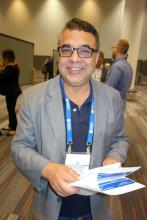SAN FRANCISCO – Serial ketamine infusions eliminated suicidal ideation in more than two-thirds of patients at a psychiatry office in Connecticut but at significantly higher doses than those recently approved for Janssen’s new esketamine nasal spray (Spravato).
The patients were treated by Lori V. Calabrese, MD, at Innovative Psychiatry, her private outpatient practice in South Windsor. She presented her first 235 IV ketamine cases at the American Psychiatric Association annual meeting. It was likely the largest real-world series to date of ketamine infusions for treatment-resistant depression and suicidality.
The patients, 14-84 years old but mostly middle-aged, received six infusions over 2-3 weeks, starting at 0.5 mg/kg over 40-50 minutes, then titrated upward for dissociative effect to a maximum of 1.7 mg/kg. Subjects filled out the nine-item Patient Health Questionnaire (PHQ-9) at baseline and before each infusion. Item nine – “thoughts that you would be better off dead or of hurting yourself in some way” – was used to gauge suicidality. That item has been validated as a predictor of suicide risk.
Among 144 patients (62%) who were markedly suicidal, ketamine infusions were tied to diminished ideation in 118 (82%) and eliminated ideation in 98 (68%). They were severely depressed at baseline; PHQ-9 scores fell in 127 (89%), and depression went into remission in 89 (62%). There were no suicide attempts, ED visits, or hospitalizations during treatment and at 4-week follow-up.
“Even if they had been suicidal for a long time, been hospitalized, and made suicide attempts, 68% had full remission of suicidality. This is a life-saving treatment, a breakthrough option for psychiatrists,” Dr. Calabrese said.
The results are “fabulous,” said Jaskaran Singh, MD, who said he was clinical leader of the esketamine program at Janssen.
“You prevented hospitalizations and saved lives,” Dr. Singh said. “This is a marvelous study that we should have done.”
Dr. Calabrese’s report, however, raises the question of whether the nasal spray will be potent enough to achieve the same results. She found that cessation of suicidal thoughts required an average dose of 0.75 mg/kg IV ketamine, which is higher than the 0.5 mg/kg used by many ketamine infusion programs in the United States. It’s also significantly higher than Spravato dosing. The spray was cleared by the Food and Drug Administration in March for use with an oral antidepressant for treatment-resistant depression. It was the subject of much buzz at the APA meeting.
Esketamine is approved in doses of 56 mg, which works out to almost 0.2 mg/kg, and 84 mg, which works out to less than 4 mg/kg. Dosing is twice weekly at first, then weekly or biweekly for maintenance.
When asked whether he thought those doses would be enough to prevent suicide, Dr. Singh said his company has finished two trials in suicidal patients and would present results later in 2019.
Dr. Calabrese, meanwhile, plans to incorporate intranasal esketamine into her practice, but will continue to offer ketamine infusions. “How can I not? I’ve seen how effective they are,” she said.
She charges $500 per session, $2 for the ketamine plus nursing and other costs. Insurance companies have sometimes covered it for patients with a history of psychiatric ED visits and hospitalizations, on the grounds that infusions will prevent future admissions. But patients have to fight for coverage – and feel well enough to do so.
That’s the main reason Dr. Calabrese plans to start offering Spravato; coverage will likely be less of a hassle for patients once Janssen works out the insurance issues. Spravato has been reported to cost about $600-$900 per treatment session.
She noted that response among her infusion patients was bimodal, with suicidal ideation eliminated in some patients after one infusion, but most of the rest needed three or more. “Don’t give up,” she said.
Infusion response correlated with suicidality and depression severity, with the sickest patients having the most benefit. Among 91 moderately depressed, nonsuicidal patients, just over half responded to the infusions, and depression went into remission in about a third.
Side effects were minimal, transient, and easily handled in the office. A little bit of IV midazolam calmed patients who got too anxious, and IV ondansetron (Zofran) helped those who got nauseous. Blood pressure can bump up a bit with ketamine, so Dr. Calabrese follows it closely.
The report had no external funding and Dr. Calabrese had no disclosures.



